Die überblendete Natur
Fotografien sind immer ‚Lichtbilder’, wie man im 19. Jahrhundert das neue Medium zunächst bezeichnete. Bis heute entfaltet das fotografisch gewonnene Bild umso mehr Vielfalt und Komplexität, je mehr Licht oder Lichtbereiche bei der Aufnahme auftreten. Mit der Fähigkeit, den Lichteinfall zu speichern, siegt die Fotografie zugleich über die Wahrnehmung des menschlichen Auges. Während der Mensch ‚nur sieht, was man sieht’ (wie der berühmte Slogan von Frank Stella lautet, mit dem der amerikanische Künstler auf die blanke Realität seiner Farben und seiner Farbstoffe verwies), kann die Kamera Lichtbilder festhalten, die wir nicht erleben können: Überblendungen, Überlagerungen, Lichtbrechungen, die einer anderen Zeit als dem reinen Augen(!)blick geschuldet sind.
Genau hier setzt Michael Wesely an. Ihn interessieren gerade diese, für den Menschen nicht sichtbaren Anteile der Fotografie, die aber paradoxerweise dennoch zeigen, was wir kennen. Denn Michael Wesely wendet die Fotografie nicht ins Abstrakte, sondern er bleibt bei der Abbildung von Landschaften, Straßenszenen, Interieurs und Gegenständen. So sind auf einer ersten Ebene die Motive seiner Bilder in der Galerie am Stein auch rasch benannt: ein Baum im Gegenlicht, zwei Menschen in einer Badewanne, ein Busch und ein Rasenstück sowie Besucher in einer Ausstellung. Damit ist jedoch noch nichts über den eigentlichen Charakter dieser Fotografien gesagt. Ihr ungemeiner Reiz, ihre Komplexität liegt gerade in den offenen Umrissformen, die in den Lichtbildern
vorliegen. Es ist jeweils eine Entgrenzung der Körper und Gegenstände, die durch eine längere Belichtung entstanden sind und die neue Perspektiven auf so bekannte Terrains wie Natur oder Innenräume eröffnen.
Der vom Wind über einen langen Zeitraum bewegte Baum erscheint im fotografischen Ergebnis wie von kosmischen Sonnenstrahlen durchwoben. Das Geäst ist nicht mehr nur Vordergrund, sondern zeigt sich vom Licht überblendet zuweilen auch als Hintergrund, vor dem die Sonne vorüber gezogen ist. Im Fall des Rasenstücks entsteht durch den extremen Kontrast von Schärfe und Unschärfe ein Moment der Künstlichkeit, ein formales Spiel aus grünen Strukturen und Farbnuancen. Die Lichtflecken wiederum im Badewannenbild kreiieren Körper, für die es in der Wahrnehmung des Menschen keine Entsprechung gibt und die dadurch ins Magische kippen. Das Museumsbild, aufgenommen in der Gerhard Richter-Ausstellung in Berlin, gibt schließlich weiteren Aufschluss über die Künstlichkeit dieser fotografischen Werke. Im Zusammenspiel mit Richters Malerei entlarven sich Weselys Lichtbilder als ebenso offene, variable Kompositionen wie im anderen Fall die Gemälde aus Acryl und Öl. Gerade auch Gerhard Richter bewegt sich mit seiner Kunst im Grenzgebiet von Abbildung und Abstraktion. Vorgefundene und oft über die Fotografie überlieferte Motive setzt Richter malerisch so sehr in Schichten, Formen und Flecken um, dass eine eigene, vom Bildmotiv ganz abgelöste Bildsprache entsteht. Nicht anders verhält es sich bei Michael Wesely: auch hier sind seine ‚Ansichten’ nur noch lose mit dem eigentlichen Bildgegenstand verbunden und lösen sich in eine schier abstrakte Lichtsprache auf.
Dieser ‚malerische’ Ansatz verbindet Michael Wesely auch mit einer Kunst, die genau diesen Wechsel von Lichtwirkungen in den Fokus nahm, nämlich die französische ‚plein air’-Malerei des 19. Jahrhunderts. Man denke beispielsweise an Claude Monet, der sich im Spätwerk von erzählerischen Bildmotiven demonstrativ abwandte und stattdessen Heuhaufen, Baumreihen und Fassadenausschnitte zum Vorwand nahm, um wechselnde Lichtstimmungen detailliert zu untersuchen. In einem überlieferten Brief beschrieb Claude Monet, es gehe ihm in der Malerei vor allem um zweierlei, um die Wiedergabe der ‚l’instantanéité’, der Augenblicklichkeit, und um ‚l’enveloppe’, um die Sphäre um den Gegenstand. Tatsächlich gelang es Monet, seine Motive ganz als flimmernde Formen, als Lichtkörper, darzustellen, deren Umrisse von hellen Sonnenfarben überstrahlt, offen und vage geworden sind. Gustave Geffroy, der große Kritiker und spätere Monet-Biograf hatte Monet gerade deshalb als „Maler des Unsichtbaren“ gefeiert.
Michael Wesely kehrt mit seinen Werken an diesen aufregenden Punkt der Kunstgeschichte zurück, erforscht mit den bisher fast erstaunlich wenig genutzten Belichtungsmöglichkeiten der Kamera das weitere Abbildungspotential der Fotografie. Waren die früheren, großen Serien von Wesely zum Potsdamer Platz, zur Neuerrichtung des ‚Museum of Modern Art’ in New York oder auch viele Straßenszenen vor allem den Zeitverläufen gewidmet, mit denen gesellschaftliche oder urbane Prozesse in den Vordergrund rücken, lenken die vier Bilder in der Galerie am Stein in ihrer Verdichtung auf eine temporäre, fast impressionistisch zu nennende Stimmung den Blick viel stärker auf die Wirkung des Lichts. Das Spektakel ist nunmehr nicht der Großstadt-Umbau, sondern das neue
‚Gesicht’ der Natur, der Körper und der Menschen im Raum. Einfache, ganz vertraute Motive und Gegenstände scheinen in Michael Weselys Bildern wie verwandelt, nehmen den Charakter surrealer Erscheinungen an. Es sind virtuose Aufzeichnungen, die über die Idee der Abbildung weit hinausgehen und eine malerische Dimension des Fotografischen offenbaren.
Joachim Jäger
Cross-Faded Nature
Photographs are always Lichtbilder (images of light), as the products of the new medium were first known in German during the 19th century. To this day, a photographically produced image will unleash its variety and complexity in direct proportion to the amount of light or areas of light represented. At the same time, a photograph triumphs over the perception of the human eye through its capability of capturing the occurrence of light. Like Frank Stella’s well-known slogan, with which the American artist referred to the naked reality of his colors and pigments, “What you see is what you see,” a camera can capture images of light that we cannot experience: fades, overlapping, refractions, which are indebted to another passage of time than the momentary blink of an eye!
It is precisely at this juncture where Michael Wesely operates. He is most interested in those aspects of a photograph that are not visible to the human eye, but which nevertheless, paradoxically, show us what we know. Yet, Michael Wesely does not turn a photograph into an abstraction, but remains true to the illustration of landscapes, street scenes, interiors and objects. As a result, on one level, the motifs of his photographs at the Galerie am Stein are quickly listed: a tree in backlight, two people in a bathtub, a bush and a patch of grass, as well as visitors to an exhibition. However, this says nothing about the real character of these photographs. Their uncommon charm and their complexity lies precisely in the open-formed contours that exist in the photographs. In each case it is a blurring of the boundaries of bodies and objects, which have been created from extremely long exposure times that open up new perspectives within known terrain, such as nature or interiors.
In its photographic manifestation, a tree set in motion by the wind over a longer period of time appears to be interwoven as if by cosmic sunbeams. The branches are no longer just foreground, but now and then they appear as background superimposed with light, against which the sun has passed through. In the case of the patch of grass, a moment of artificiality – a formal game of green structures and color nuances – originates from the extreme contrasts of sharpness and diffuseness. In turn, the spots of light in the photograph of the bathtub create bodies for which there is no analogy in human perception, consequently crossing a line into the realm of the magical. The museum image, taken at the Gerhard Richter exhibition in Berlin, ultimately provides further insight about the artificiality of these photographic works. In an interplay with Richter’s painting, Wesely’s photographs reveal themselves to be just as open and variable compositions as the paintings in acrylic and oil made by the other artist. In his work, Gerhard Richter moves between the two borders of illustration and abstraction. Richter often takes known motifs or those traditionally found in photography, and transforms them into layers, forms and spots to such a degree that a visual, painterly language of his own is created, which completely departs from the original pictorial motif. Michael Wesely does not react any differently: His “views” are only loosely connected to the real pictorial subjects and dissolve into a nearly abstract language of light.
This “painterly” approach also connects Michael Wesely with 19th century French “plein air” painting; namely, an art movement that focused precisely on this alternation of the effects of light. Claude Monet comes to mind, who demonstratively turned away from narrative picture motifs in his late work, and instead took haystacks, rows of trees and segments of building façades as his pretext to examine changing lighting effects in detail. In a preserved letter, Monet described the two different things that he felt to be most important to him in painting: the reproduction of “l’instantanéité” (momentariness) and “l’enveloppe” (the sphere surrounding an object). Monet actually managed to represent his motifs entirely as shimmering forms, as objects of light whose sundrenched contours have become open and vague. For this reason, Gustave Geffroy, a well-known critic and Monet’s later biographer, celebrated the artist as a “painter of the invisible.”
In his works, Michael Wesely returns to this exciting point of art history, further investigating the illustrative potential of photography by taking advantage of a camera’s variable exposure times – a technique that has been used astonishingly little up to now. While Wesely’s works previously dealt with his large series depicting Potsdamer Platz, the reconstruction of the Museum of Modern Art in New York, or the many street scenes that were primarily dedicated to elapsed time – where social or urban processes shifted into the foreground – the concentrated view of the four photographs at the Galerie am Stein focus much more strongly on the effects of light; on a temporary, and what can almost be called an impressionistic atmosphere. The spectacle is no longer concerned with the restructuring of the big-city, but with the new “face” of nature, the body and people in space. Simple, very familiar motifs and subjects seem to change in Michael Wesely’s images, taking on the character of surrealist apparitions. They are virtuoso recordings, which go far beyond the idea of illustration to reveal a painterly dimension within the photographic.
Joachim Jäger
|
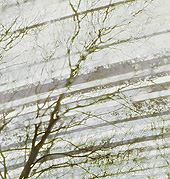
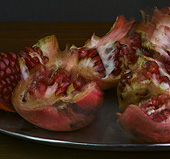
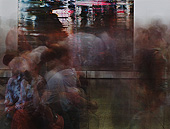
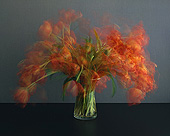
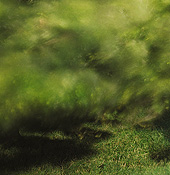
|




